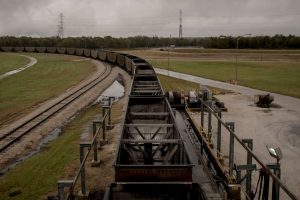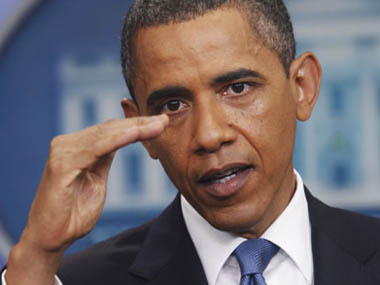DECEMBER 26, 2018
 A freight train that carries coal to the W.A. Parish power plant in Thompsons, Texas. – Gabriella Demczuk / NY Times
A freight train that carries coal to the W.A. Parish power plant in Thompsons, Texas. – Gabriella Demczuk / NY Times
For nearly two years, President Trump has pursued an aggressive, far-reaching effort, lobbied for and cheered on by industry, to free American business from what he and many of his supporters view as excessive environmental regulation.
The consequences are starting to play out in noticeable ways in communities across the United States.
An investigation by The New York Times showed how Mr. Trump’s deregulatory policies are starting to have substantial impact on those who experience them close up — and often are economically dependent on the industries the president is trying to help.
Here are five takeaways:
Trump has quickly undercut Obama’s legacy
President Barack Obama made protecting the environment a big part of his legacy. His administration, over eight years, carefully developed rules designed to clean up the environment, deter climate change and protect against dangerous chemicals. Many were completed in the final stretch of his presidency, often in ways that bypassed Congress.
But industry consistently balked at those regulations, calling them an overreach, duplicative and unnecessary, unleashing a backlash that has informed Mr. Trump’s approach.
So, with equal decisiveness, Mr. Trump has sought to undo his predecessor’s agenda by blocking, delaying and killing measures. The Trump administration cited its rollbacks as a victory and the fulfillment of a campaign promise.
The rapid change in policy direction shows how both presidents used their expansive executive powers — but for very different outcomes.
Environmental impacts span the country
The early impacts of the Trump rollbacks are beginning to emerge across the country, from California to North Dakota, Texas and West Virginia.
The Times visited the communities facing these changes, and found that local residents and business leaders are often divided. Some believe that the Obama administration went too far in imposing new environmental demands, while others worry that the changes the Trump administration is making will hurt their families, in particular their children.
The geographic diversity of the places grappling with the trade-offs highlights how pervasive the connections are between natural resources, health and economic opportunity.
In the vast farmlands of central California, day care centers have to take account of pesticide-spraying schedules. The local government’s revenues on the Fort Berthold Indian Reservation in North Dakota have grown to $330 million from $20 million over the last 15 years because of vast fossil fuel reserves that can now be pumped from the ground using fracking. National forests 400 miles away can be clouded with haze produced by a coal-fired power plant near Houston.
The rollbacks touch air, water, chemicals and climate
No parts of the federal government during the Trump era have been more aggressive in rolling back rules than the Environmental Protection Agency and the Interior Department, which between them regulate much of the intersection between the environment and the economy. Together their rule changes have touched nearly every aspect of environmental protection, including air pollution caused by power plants and the oil and gas industry, water pollution caused by coal mines, and toxic chemicals and pesticides used by farmers nationwide.
In short, what is at stake is the quality of the air we breathe and the food we eat, the cleanliness of the rivers that flow past us, and the pace at which the climate is changing. Two years after Mr. Trump took office, the policy shifts are not nearly complete; dozens of other rules have been targeted for rollback.
After decades of legislation and regulation, the environment in the United States continues to get cleaner. What has changed under Mr. Trump in most cases is the pace of improvement, which has been slowed in a number of key areas compared to what it would have been if the Obama rules had been preserved.
The decline of coal has not been stopped
If there is a single industry that has been at the center of the fight — both during the Obama expansion of rules and the Trump rollbacks — it is coal. Mr. Obama targeted the industry as a way to combat climate change. Mr. Trump has defended and promoted it as part of his populist political and economic strategy.
Mr. Trump’s approach has been to slow demands for further steps to curb air and water pollution caused by coal-burning power plants.
The tug-of-war involves coal mines as well, which were ordered by Mr. Obama to take steps to help clean thousands of miles of rivers and streams, only to be told by Mr. Trump that these measures were no longer necessary.
What has not changed is the decline of coal — both coal mines and coal-burning power plants. Even as Mr. Trump has used his executive powers to help the industry, coal production in the United States continues to decline. As the Energy Department announced this month, the country’s coal consumption for 2018 is “expected to be the lowest in 39 years.” The decline is mostly a result of power plants shifting away from burning coal.
Progress is slowing — but there’s still progress
At the core of the fight between environmentalists and the Trump administration is a debate over a simple question: How much improvement is enough? By some measures — such as overall emissions of sulfur dioxide and nitrogen oxide, two major air pollutants that cause smoke and haze and a variety of health ailments — environmental quality in the United States has continued to improve in the Trump era.
That is in large part because of the rapid closure of more coal-burning power plants. But the pace of those declines would almost certainly have been greater had Obama-era policies continued. So what is happening in the United States is a slowing of the pace of progress — not a return to the era, before the E.P.A. was created in 1970, where a river in Ohio caught fire.
Another factor is that environmental change happens slowly. So the real impact of the Trump-era policies may not be fully apparent until years after Mr. Trump leaves office.
Courtesy/Source: NY Times

































































































